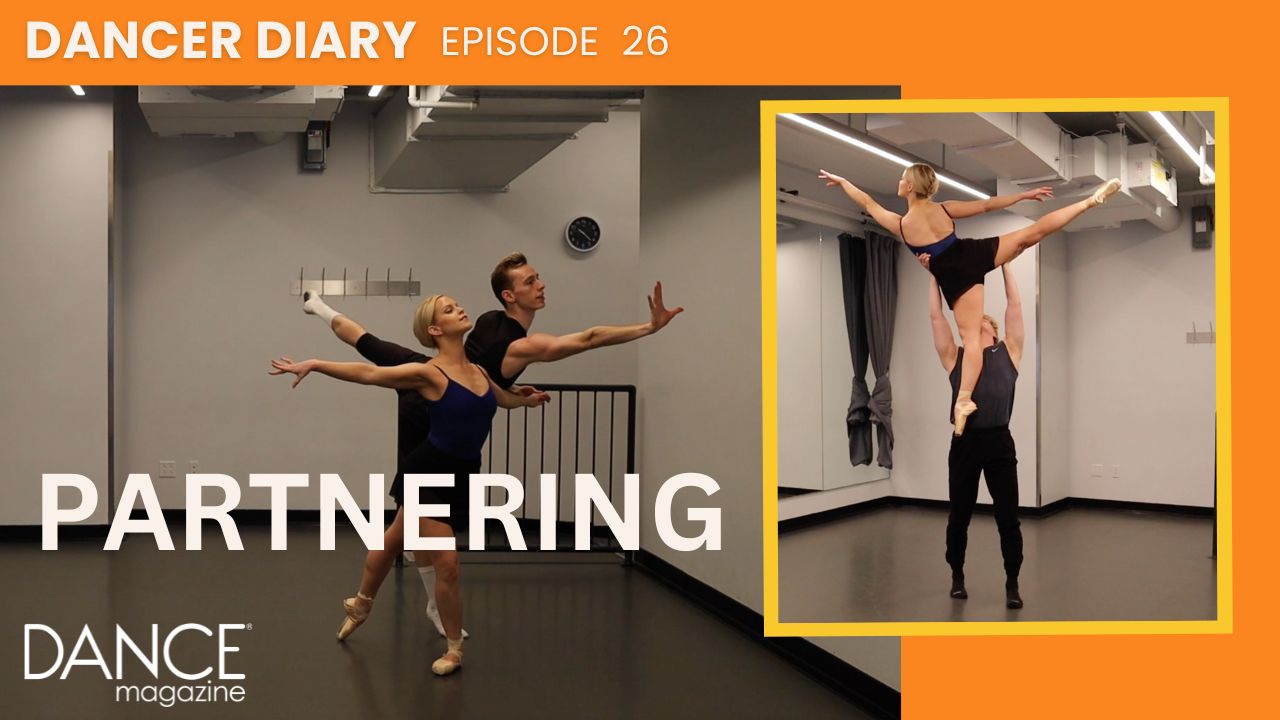Dancer Diary: The Partnering Predicament
Partnering is an essential part of a professional dance career, yet it’s nearly impossible to keep those skills up to date as an adult. Try as I might, I have yet to find an open partnering class in New York City. (If you know of one, please let me know!) So, how can I make sure I’m ready to do my best in an audition or on the stage if I don’t have a great way to practice?
I decided to take matters into my own hands. I spoke with former Paul Taylor dancer and current Adelphi University professor Orion Duckstein to get some essential partnering tips and tricks. Then, I got into the studio to practice with two of my fabulously talented friends, Tade Biesinger and Luke Rands. The experience was so positive that we all decided we need to make partner practice a regular part of our training regimen.
Here are six partnering takeaways from my time working and talking with each of these pros.
1. Be both confident and humble.
“The only thing that really gets in the way of partnering is insecurity or pride,” Rands says. Self-conscious energy can make it difficult for pairs to trust and work together. “There’s a tendency to constantly be apologetic and say ‘It’s my fault,’ when it’s actually trial and error,” Biesinger says of those times partnering goes wrong. While he feels there is a time and a place to give a heartfelt apology in partnering (like when you accidentally hit someone in the nose), more often than not, Biesinger recommends just moving forward patiently.
On the flip side, Rands says artists need to be open to accepting corrections rather than responding defensively to feedback. “With that mentality, it won’t look good, and it won’t feel good,” he says. “If you approach it with an open mind, things will get a lot better.”
2. Communicate.
As with any kind of relationship, communication in partnering is key—starting with consent. “Ask your partner if they are comfortable with where you need to place your hands, or if it’s okay if you stand close,” Duckstein says. Once that’s established, dancers should speak to their partners with kindness, but without pandering. “If I approach a partner who needs to jump a bit more and say, ‘I’m so sorry, I know this is a lot to ask, but could you maybe jump a bit more?’ it becomes a bigger deal and creates friction,” he says. “But if I say, ‘Hey, it would help me if you plié a little bit more,’ it sets a precedent that it’s not personal, I’m not stressed about it, and it’s just part of the game.”
3. Match musicality.
If you study ballet, Duckstein recommends standing behind your partner in class and matching the timing of your barre work to theirs. “It increased my sensitivity as a partner,” he says. “I discovered if my partners had a tendency to move at the front of the beat or the back of the beat, and adjusted myself to match them. It made a big difference.”
4. Maintain physical contact.
According to Duckstein, one of the most important parts of partnering is how you get into and out of each step. He recommends taking special care to maintain physical contact in those moments. “Even just keeping your arm on your partner’s back for a second longer than you think you need to will allow them to know they are supported and can rely on you,” he says.
5. Don’t shorten your plié.
One of the simplest ways to be a reliable partner is to make sure your body’s momentum and, especially, your pliés are clear and easy to read. “It’s kind of like handing someone a cup of tea: You don’t let go until you know they have it,” Duckstein says. “A clear plié lets your partner know when you’re ready for what comes next.”
6. Practice!
Just because there aren’t many partnering classes out there doesn’t mean there aren’t ways to do it on your own. While on tour with Anastasia last year, Rands and his friends used the extra time during their lift calls to research and try new lifts. “Take every opportunity to learn from your friends and figure out what works for you,” he says. For something a little more formal, Duckstein recommends contact improvisation classes, which will familiarize you with weight-sharing and other aspects of partner work.
Head on over to Dance Magazine’s YouTube channel for a look inside our partnering rehearsal, as well as my full interview with Biesinger and Rands.




